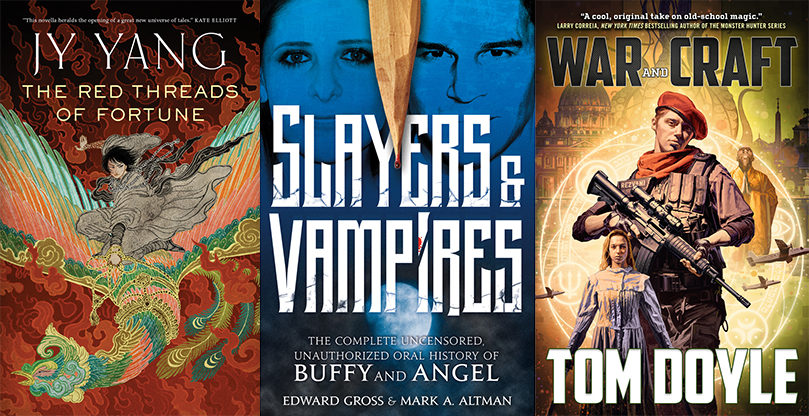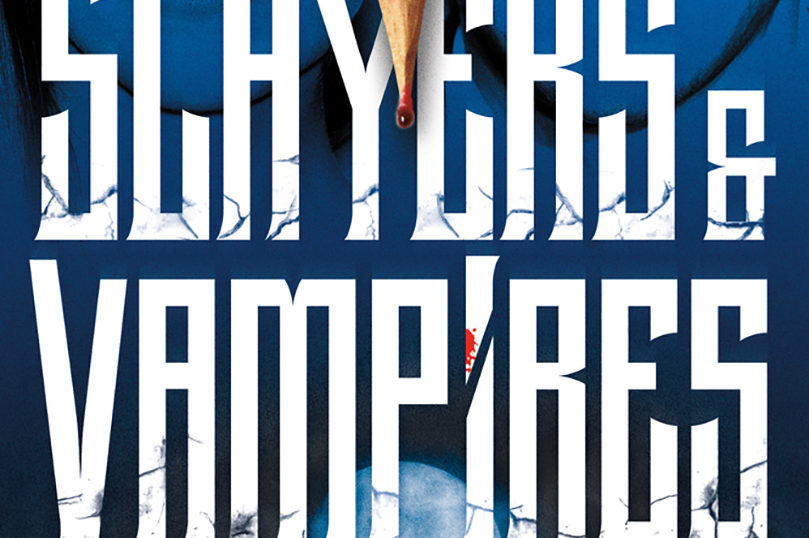opens in a new window opens in a new window
opens in a new window opens in a new window
opens in a new window opens in a new window
opens in a new window opens in a new window
opens in a new window opens in a new window
opens in a new window
opens in a new window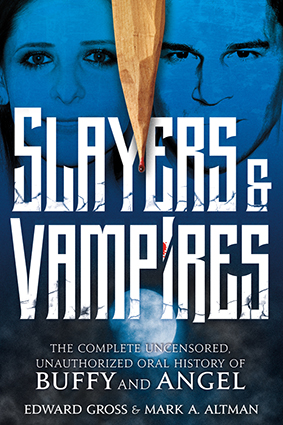
Two decades after its groundbreaking debut, millions of fans worldwide remain enthralled with the incredible exploits of Joss Whedon’s Buffy Summers, the slayer and feminist icon who saved the world…a lot; as well as Angel, the tortured vampire with a soul who fought against the apocalyptic forces of evil.
Now, go behind-the-scenes of these legendary series that ushered in the new Golden Age of Television, with the candid recollections of writers, creators, executives, programmers, critics and cast members. Together they unveil the oftentimes shocking true story of how a failed motion picture became an acclaimed cult television series, how that show became a pawn between two networks, and the spin-off series that was as engaging as everything that came before.
This is the amazing true story of Buffy and the friends, vampires, slayers, and demons who changed television forever.
opens in a new windowSlayers and Vampires: The Complete, Uncensored, Unauthorized Oral History of Buffy The Vampire Slayer & Angel will become available September 26th. Please enjoy this excerpt.
ONCE MORE, WITH KNEALING
By Mark A. Altman
“She’s cool. She’s hot. She’s tepid. She’s all-temperature Buffy.”
Make no mistake, Joss Whedon is a god.
Not a Zeus-like god who hurls thunderbolts from the sky and demands sacrifices of goats, chickens, geese, and the occasional vestal virgin, but an honest-to-goodness writing deity, a wizard of words, a maestro of the macabre and liege of letters. Not to mention he’s far more partial to plaid button-downs than togas. But, not unlike Vargas on the receiving end of a spear gun from 007, you get the point (or Mr. Pointy, in his case). If that fact got lost on us during his less-than-halcyon days, when Whedon wrote for the mouthy Roseanne and Dan, resurrected Alien, or even when he debuted the first Buffy, who failed to slay audiences on movie screens in 1992, by now it should be abundantly clear to those of us fortunate enough to have been hip to the oeuvre of Joss Whedon, this is a man of boundless creativity, thoughtfulness, passion, intelligence, and wit.
Are you not entertained?
In a medium and a genre in which sexy blond girls were cannon fodder for the creepy-crawlies that go bump . . . and slash . . . in the night, Whedon flipped the script. Instead of being the prey, the lithe little blond girl with the silly name was the predator, keeping the troubled town of Sunnydale safe from all manner of nefarious and apocalyptic threats to her friends and family, from points north, west, south, and east. It’s been said before but it’s worth reiterating that Buffy didn’t take place in the high school world of a John Hughes comedy, it used its supernatural trappings as a metaphor for the challenges and pain of adolescence. Not many of us could relate to growing up in a small town terrorized by soulless vampires, goblins, and ghouls, but most can relate to stories of unrequited love (or lust), sexy and soulful mysterious strangers, insular high school cliques, and cheerleaders whose bodies are possessed by their obsessed mothers. OK, not so much that last one.
High school drama had come a long way since Glenn Ford in The Blackboard Jungle. And what makes Buffy so unique is that it stands as perhaps one of the last vestiges of a more innocent age of adolescence, before social media and iPhones. When Buffy was created, it was still the era of creaking plot mechanics that could hinge on a missed ring on the landline phone, and in which the only social network in a town like Sunnydale was hanging out at a place like the Bronze while listening to music from a procession of great to middling ’90s bands. Buffy was delivering its swan song to the more innocent days of high school just as the first glimmers of social networking were arriving on the scene with Friendster (remember that short-lived precursor to Myspace and Facebook?). Buffy would be a very different show today: the denizens of Sunnydale would be snapchatting and tweeting about Mayors transforming into giant lizard gods and hellish Halloween celebrations. “For god’s sakes, stay away from Ethan’s and lay off the Band Candy.” Is that more than 140 characters?
Meanwhile, Whedon’s spin-off of Buffy, Angel, is a miraculous story of survival against all odds. The series debuted with David Boreanaz’s titular vampire as Philip Marlowe lite attempting to redeem himself on the mean streets of the City of Angels in a ham-fisted, noir-tinged detective drama. Sputtering for nearly half a season, the show began to find its own distinct identity, miraculously and brilliantly reinventing itself several times, first when Cordelia was bequeathed the visions of the late Glenn Quinn’s Doyle, and then when Angel Investigations took up residence in an abandoned art deco hotel, and, finally, when Angel and company would find themselves in charge of the evil law firm Wolfram and Hart. What was stunning was that despite the seemingly inane, high-concept TV Guide description—“Angel, the vampire with a soul, is forced to run an evil law firm in Los Angeles” (redundant, to be sure)—the show’s dramatic reinvention for its fifth season was a home run, and, much like Next Generation’s darker, more brooding spin-off Deep Space Nine, Angel often outshone its progenitor, despite having a smaller audience and receiving far less critical acclaim.
Embracing a more serialized structure than its progenitor, Angel required a more serious commitment from viewers of the pre-DVR age, who would be amply awarded for their loyalty (although I vaguely recall purchasing my first TiVo around that time, and I still have my plush Mr. TiVo to prove it). As Buffy began sputtering to its inevitable conclusion, Angel continued to evolve, culminating in one of the great series finales of all time, a supernatural Godfather denouement, a cliffhanger that is, regrettably, unlikely ever to be resolved. Not since Mike Torello and Ray Luca grappled violently in the cockpit of a rapidly descending Cessna in the second-season capper of Crime Story had a series left you hungering for more as the axe swung.
And since the respective conclusions of Buffy and Angel, Whedon has continued to amass quite the filmography (a subject for another book, surely). He rarely repeats himself and, no matter how disparate the material, marks his work with a singular style and wit. Even without Joss Whedon’s name in the opening credits, it’d be hard to miss his unique imprimatur on such a diverse array of film and television as 2002’s Firefly, the addictive, short-lived cult sci-fi western about a ragtag group of underdogs and misfits long before Guardians of the Galaxy made such things en vogue and 2012’s The Avengers, featuring a distinctly different band of underdogs and misfits who save the world and transformed Whedon from a revered cult figure to a bankable blockbuster film director, all while he knocked out the microbudget adaptation of Shakespeare’s Much Ado About Nothing, a charming and delightful retelling of the Bard’s whimsical comedy, which gets a very Whedonesque makeover and was shot in his backyard. He made the film on a shoestring between Hammer time and Hulk busting. Doesn’t this man sleep? Apparently not.
Meanwhile, there was the far less successful Eliza Dushku vehicle for Fox, Dollhouse; the genre-subverting The Cabin in the Woods, directed by Buffy veteran and future Martian Oscar nominee Drew Goddard, which Whedon and Goddard cooked up in a matter of days and that harkens back to horror classics like Sam Raimi’s Evil Dead but has a distinctly Whedonesque spin; and the beloved Dr. Horrible’s Sing-Along Blog, with the always delightful Nathan Fillion as the preening, narcissistic superhero Captain Hammer, a dastardly and lovestruck Neil Patrick Harris as Dr. Horrible, and an adorable Felicia Day. (And I would know since I’ve been lucky enough to work with both of them, the awesome and avuncular Nathan on Castle and Felicia on The Librarians, where we played hours of Lord of the Rings pinball with Sean Astin, but that’s a story for another time.)
As a television writer myself, it’s hard not to appreciate Whedon’s sheer talent and prodigious output, which I’ve always enjoyed, respected, and admired. My personal connection to Whedon predates this book by over two decades. When I first moved to Los Angeles and was working as a journalist for Sci-Fi Universe, the self-proclaimed magazine for science fiction fans with a life that I had started for Larry Flynt, of all people, I attended a Writers Guild mixer, where I first encountered Joss, in his ubiquitous and unmistakable uniform of T-shirt, jeans, and button-down plaid shirt. We talked for a while about his new film, Toy Story. He was excited and equally trepidatious about the film’s imminent release, Pixar’s first. He’d already become one of Hollywood’s most accomplished go-to guys for script fixes, doing substantial uncredited rewrites from films ranging from l994’s Speed to 1995’s infamous Waterworld which contributed a new twist to the seemingly immutable Hollywood axiom: Never work with kids or animals and definitely never, ever shoot on water. We all know now, of course, that the first Toy Story is a triumph, one of the great animated films of all time, and became a perennial favorite for a generation of children (and adults). But I’ll never forget walking out of the Crest Theatre in Westwood during the opening weekend to find Joss ensconced in the shadows of the back row quietly watching the film—and the audience. Surprised, I approached him and asked what he was doing watching his own film, which he had assuredly seen many times already. Chagrined and embarrassed, a nervous Whedon smiled, answering he didn’t want anyone to recognize him, hoping to anonymously see if the film played with a real, paying audience. Indeed, it did—it was nothing short of a masterpiece. That was the last time I ever saw that side of Joss. Success didn’t make him an egotist or an asshole, as it does for many in our business, but it did make him deservedly self-confident . . . and a better dresser.
After that, I would regularly run into him on Tuesdays at the late Pico Boulevard haunt, Laser Blazer, where we both used to pick up the latest laserdiscs and, later, DVDs and Blu-rays. We would have brief and amiable conversations, but I can’t say I ever got to really know him very well, although we were bonded into that community of pre-Amazon obsessives who would march out to the store every Tuesday to pick up the latest new releases on the day they came out—often leaving them in the original shrink-wrap for years. (As anyone who is still part of the dying breed of connoisseurs of physical media will adamantly and lovingly tell you, sometimes it’s just enough to know they’re there.)
Perhaps my most embarrassing run-in with Joss was years later at the Saturn Awards, the awesomely kitsch, sweet, nostalgic, and charming awards show devoted to genre entertainment held annually by the Academy of Science Fiction, Fantasy and Horror Films. For years, my wife had been consumed by a question that she desperately wanted answered. Now, you have to understand that my wonderful spouse, Naomi, is a die-hard fan of the Whedonverse and a devoted fan of Buffy and Angel. Not only did we have a string quartet play the beautiful “Sacrifice” theme from “The Gift” at our wedding and name two of our rescue cats Giles and Willow, but for her first Mother’s Day I took her to Torrance to see Sunnydale High School (aka Torrance High School) and the original Summers residence nearby. In fact, when she first moved to Los Angeles, Buffy was a great solace to her since she had left behind so many of her close friends in Chicago, and it was the gang at Sunnydale High that helped her acclimate to her new life in a new city with new friends, not unlike the slayer herself. So you see, even though I ducked having to ask her question for several years, unfortunately, when she heard that Joss was going to be at the Saturns, there was no way I was extricating myself from this unwelcome task. Naomi insisted that I talk to Joss and get a definitive answer to her vexing query.
What did she want to know, you may ask? Not far from where we live in Beverly Hills, there was a three-way intersection; at it stood the Willow School, Wesley Street, and, nestled between them and now long gone, the imposing Angelus Shoe Factory. Naomi thought perhaps this had been an inspiration to Joss when he was creating Buffy. I, of course, thought I’d never eat lunch (dinner or brunch) in this town again if I posed her question, but when your wife asks you do something—other than take out the garbage—you do it and so I did. Mortified, I approached Joss at the after party, and, after exchanging familiar pleasantries and downing a few vodka-enhanced beverages, I finally, reluctantly, asked him if indeed this had been an inspiration for Buffy. Smiling amusedly but taking pity on me by not outright laughing, he answered quietly and thoughtfully, “You can tell your wife, definitely not.” And so ended one of the all-time great, long-held mysteries of Buffy for our family.
Hopefully, however, in this volume you now hold in your hand Ed Gross and I will be able to clarify many other mysteries, dispel some apocryphal myths, hip you to the best craft services, and reintroduce you to the wonderful worlds of Buffy and Angel in a new, candid, and exciting way. The joy of writing these oral histories of such beloved pop culture staples is not only to have a chance to revisit worlds we love (like Star Trek in The Fifty-Year Mission and Sunnydale and Angel’s City of Angels in this volume) and share insider stories with passionate fans about the creation and making of these iconic series but also to showcase the behind-the-scenes tales and many of the unheralded talents of so many of these wonderful shows with those who may have never encountered them before.
At twenty years old, there’s an entire generation of TV viewers who didn’t grow up with Buffy, Willow, Xander, Cordelia, Faith, Angel, Spike, Giles, Willow, Dawn, Flutie, Snyder, Anya, Kendra, Gentlemen, Masters, and Mayors. Once they read this volume, it’s our hope they will. Buffy and Angel are distinctly products of their time. They were created early in the second golden age of television, after the emergence of series like Hill Street Blues and St. Elsewhere changed the medium indelibly forever but before the renaissance of The Sopranos, The Wire, Mad Men, and Breaking Bad. But for as long as girls love boys, kids endure the endless tortures of high school, and we question the myriad sounds that go bump in the night, Buffy and Angel will always remain timeless. The visual effects of Mayor Wilkins turning into a giant snake notwithstanding, of course. Thatdoes look pretty lame now.
October 29, 2016
VAMPIRES and SLAYERS, OH MY!
By Edward Gross
“I may be love’s bitch, but at least I’m man enough to admit it.”
Growing up in the 1960s, I had a number of pop culture obsessions, most of which are still with me, including Superman, James Bond, Star Trek, Planet of the Apes, The Odd Couple (I saw the movie when I was eight and have loved the concept ever since), and vampires.
As to the latter, I was fascinated with the classic Universal and Hammer horror movies, most notably Bela Lugosi and Christopher Lee’s takes on Dracula. But that was nothing compared with my genuine obsession with Barnabas Collins, the vampire star of television’s only gothic-horror daily soap opera, Dark Shadows. From the moment I encountered that character one afternoon after school, he’d never fully gone away (a memory solidified by the fact that there was a period in the 1980s when I was hanging out with the man who played him, the late Jonathan Frid).
Strangely, the idea of slayers—those whose chosen path was to take down my beloved vampires, among other supernatural threats—was appealing to me as well. (I don’t even want to get into the psychology of wanting to see the thing I love destroyed.) The first person I recall doing that slaying was the reporter Carl Kolchak, played by Darren McGavin, in the 1972 TV movie The Night Stalker, in which he discovered and took down a vamp haunting Las Vegas. A year later Kolchak returned in The Night Strangler and, a year after that, in the weekly series Kolchak: The Night Stalker. There was also Roy Thinnes in 1973’s The Norliss Tapes TV movie, Gene Roddenberry’s 1977 TV movie Spectre, 1984’s Ghostbusters, the following year’s Fright Night (which introduced audiences to Roddy McDowall’s Peter Vincent), and 1993’s The X-Files (of course).
But then there was Buffy the Vampire Slayer, debuting in 1997, which was an entity all its own, capturing the imagination with horror, humor, and (shockingly) three-dimensional characters as it introduced the world (and me) to Sarah Michelle Gellar’s Buffy Summers and the rest of her particular Scooby Gang. And in that mix came the vampire with a soul, Angel, as played by David Boreanaz.
One TV show with a vampire and a slayer? My mind was boggled, and since I had been a journalist for a great metropolitan newspaper . . . sorry, that was Clark Kent . . . that is, for a number of magazines, I was given an inside look at the making of the series and also of the spin-off, Angel.
But even before there was a Buffy TV show, there was Joss Whedon. Back in 1995, I was an editor at Cinescape magazine, and it was announced that a fourth movie in the Alien franchise, ultimately called Alien: Resurrection, was going to be made (really big news at the time) and that someone named Joss Whedon would be writing it. Well, back then, before every bit of information about a film fell under the full and complete control of studio publicists or the talent involved was terrified of speaking out of turn, I figured there couldn’t be too many people named Joss Whedon out there, so I called 411, information. A moment later, I had a phone number and decided to give it a call. Joss answered, I introduced myself, and we stayed on the phone for about an hour or so, engaging in what would be the first of many hours of conversation over the years. Eventually, when Buffy did become a TV series, Joss continued to make himself available to me, and he even made it possible for me to speak to many of the other writer/producers of both series. As a result, next to Star Trek, I don’t think there were any other TV shows that I covered as much as I did Buffy and Angel.
This book, then, is the culmination of my lifelong obsession with both vampires and slayers. In telling the story of Buffy the Vampire Slayer and Angel, particularly in the oral history format, it was our hope that this would be the most in depth and intimate look at two shows that, whether people realized it or not, evolved the medium. A lot.
December 31, 2016
Copyright © 2017 by Edward Gross and Mark A. Altman
Order Your Copy
opens in a new window opens in a new window
opens in a new window opens in a new window
opens in a new window opens in a new window
opens in a new window opens in a new window
opens in a new window opens in a new window
opens in a new window
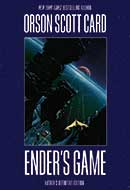 For the perfect holiday gift for the reader on your list, pick up Orson Scott Card’s Ender’s Game in this specially bound edition of the author’s preferred text.
For the perfect holiday gift for the reader on your list, pick up Orson Scott Card’s Ender’s Game in this specially bound edition of the author’s preferred text.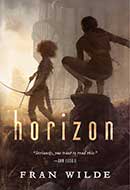 A City of living bone towers crumbles to the ground and danger abounds. Kirit Densira has lost everything she loved the most—her mother, her home, and the skies above. Nat Brokenwings—once Kirit’s brother long before the rebellion tore them apart—is still trying to save his family in the face of catastrophe. They will need to band together once more to ensure not just their own survival, but that of their entire community.
A City of living bone towers crumbles to the ground and danger abounds. Kirit Densira has lost everything she loved the most—her mother, her home, and the skies above. Nat Brokenwings—once Kirit’s brother long before the rebellion tore them apart—is still trying to save his family in the face of catastrophe. They will need to band together once more to ensure not just their own survival, but that of their entire community.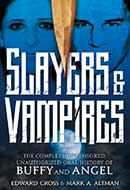 Two decades after its groundbreaking debut, millions of fans worldwide remain enthralled with the incredible exploits of Joss Whedon’s Buffy Summers, the slayer and feminist icon who saved the world…a lot; as well as Angel, the tortured vampire with a soul who fought against the apocalyptic forces of evil.
Two decades after its groundbreaking debut, millions of fans worldwide remain enthralled with the incredible exploits of Joss Whedon’s Buffy Summers, the slayer and feminist icon who saved the world…a lot; as well as Angel, the tortured vampire with a soul who fought against the apocalyptic forces of evil.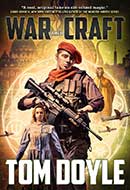 America, land of the Free…and home of the warlocks.
America, land of the Free…and home of the warlocks.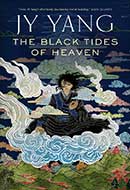 Mokoya and Akeha, the twin children of the Protector, were sold to the Grand Monastery as infants. While Mokoya developed her strange prophetic gift, Akeha was always the one who could see the strings that moved adults to action. While Mokoya received visions of what would be, Akeha realized what could be. What’s more, they saw the sickness at the heart of their mother’s Protectorate.
Mokoya and Akeha, the twin children of the Protector, were sold to the Grand Monastery as infants. While Mokoya developed her strange prophetic gift, Akeha was always the one who could see the strings that moved adults to action. While Mokoya received visions of what would be, Akeha realized what could be. What’s more, they saw the sickness at the heart of their mother’s Protectorate.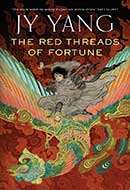 Fallen prophet, master of the elements, and daughter of the supreme Protector, Sanao Mokoya has abandoned the life that once bound her. Once her visions shaped the lives of citizens across the land, but no matter what tragedy Mokoya foresaw, she could never reshape the future. Broken by the loss of her young daughter, she now hunts deadly, sky-obscuring naga in the harsh outer reaches of the kingdom with packs of dinosaurs at her side, far from everything she used to love.
Fallen prophet, master of the elements, and daughter of the supreme Protector, Sanao Mokoya has abandoned the life that once bound her. Once her visions shaped the lives of citizens across the land, but no matter what tragedy Mokoya foresaw, she could never reshape the future. Broken by the loss of her young daughter, she now hunts deadly, sky-obscuring naga in the harsh outer reaches of the kingdom with packs of dinosaurs at her side, far from everything she used to love.
